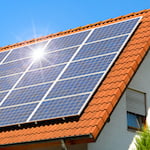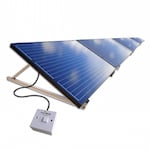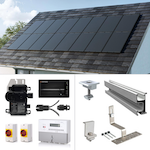Which Plug-In Solar Kit Should I Choose?
Residential solar power kits are generally available up to 3.68kW (3680W), in order to stay within the UK regulations. Our Plug In Solar Kits are available from 405W and rise in increments up to the largest systems.
With many sizes to choose from, you may find yourself asking; ‘What size Plug-In Solar kit do I need?’
An quick and easy way of determining which kit will be suitable for your needs is to use our helpful chart:

However if you want a more detailed approach, there are 3 key areas to consider when choosing the correct size Plug-In Solar Power kit for your requirements.
• How much electricity do you / will you use?
• How big is the area where the panels will be installed?
• Your budget?
How much electricity do you / will you use?
The most reliable point of reference for a retrofit solar kit will be the existing electricity bills for a property. Each home has a ‘base load’, which is the amount of energy used in an average day/week/month to power all the appliances in the property. You can work this out for your property by looking at your own electricity bills, or keeping records using your electricity meter.
According to OFGEM, an average household with medium energy consumption uses between 3200 and 4200 kWh per annum.
Taking the higher end of this scale (4200kWh) and dividing by 12 (for months of the year), the result is an average 350kWh per month. Let’s assume you wish to cover 50% of your energy usage, so 175kWh per month.
You will then need to know the average kWh per month each Plug-In Solar Kit generates. This information can be found in the downloads section of each Plug-In Solar Kit listing.
A 250W Plug-In Solar Kit generates approximately 247kWh per year (please see Plug-In-Solar-250W-Energy-Generation document), that’s an average of around 20kWh per month.
This would mean that 9 x 250W solar panels, making up a 2.25kW (2250W) Solar Kit, are needed to cover an estimated 50% of the total average electricity costs for the example household. (9 x 20kWh = 180kWh per month).
How big is the area where the solar panels will be installed?
Plug-In Solar kits can be installed on tiled/slate or metal/wood pitched roofs, flat roofs, or on the ground. The number of panels you can install may be limited by this available area, but please ask us for help with designing your system, so we can help you achieve the biggest possible system for your needs.
What size solar power kit will fit the available budget?
Your budget will ultimately dictate the size of the solar panel kit that can be purchased. A lower budget will require a compromise on the number of panels you can install. This means that the percentage of the energy costs covered by the panels will also be lower, but you will still make savings.
As Plug-In Solar kits are modular in nature, it is possible to buy the kits incrementally, starting off small and building up a to bigger kit. This also helps spread the cost across a few months/years. However, if the budget is higher and space allows, it is worth considering increasing the number of solar panels. This will maximise the levels of energy that the solar panels will generate for the property, resulting in bigger savings.
Extra Savings
In addition to installing solar panels, there are also a number of other ways in which you can save energy, or use energy more efficiently in your property, which will help you save even more money on your bills.
Such items include:
• LED Lighting – You could save up to £240 per year: http://www.telegraph.co.uk/finance/personalfinance/householdbills/10756999/How-to-save-240-a-year-with-LED- lightbulbs.html
• Energy Recovery Devices – Energy Recovery Devices, such as the SOLIC 200 Immersion Diverter allow you to divert any excess electricity from the solar panels to your immersion. This allows you to heat up your water with electricity from your solar panels.
• Energy Storage – Domestic energy storage systems, such as batteries, allow you to store energy from the solar panels and use it later on. Please ask us for further information on our range of energy storage options.
• Timer Switches – Modern timer switches allow the user to turn on appliances remotely. This enables you to run appliances more efficiently during times when the solar panels are producing the most energy.
For more information on any of the above, please contact us by email: info@pluginsolar.co.uk, or on our telephone helpline: 01444 672005.
If you are looking to power something bespoke, need a system that is larger than 4kW, or require an off grid solar kit, we can help. We recommend contacting our helpline to assist with these customised calculations.
Disclaimer: The performance of solar PV systems is impossible to predict with certainty due to the variability in the amount of solar radiation (sunlight) from location to location & from year to year. All estimates are based upon the Government’s standard assessment procedure for energy rating of buildings (SAP) and is given as guidance only. Illustrative solar PV performance figures only. Figures are given in good faith but do not constitute “Financial Advice”. Yearly PV output uses a factored degradation over time based on industry estimates. Photovoltaic Panels will not be shaded (e.g. by Trees or Buildings) as shading affects PV output. Specific appliance ratings and equipment age will affect energy consumption and these examples are guidelines only. Figures obtained fromwww.solarguide.co.uk/solar-pv-calculator.




